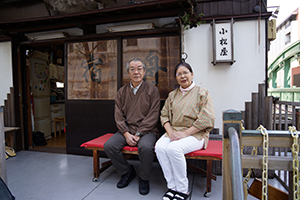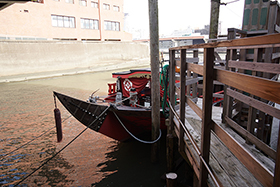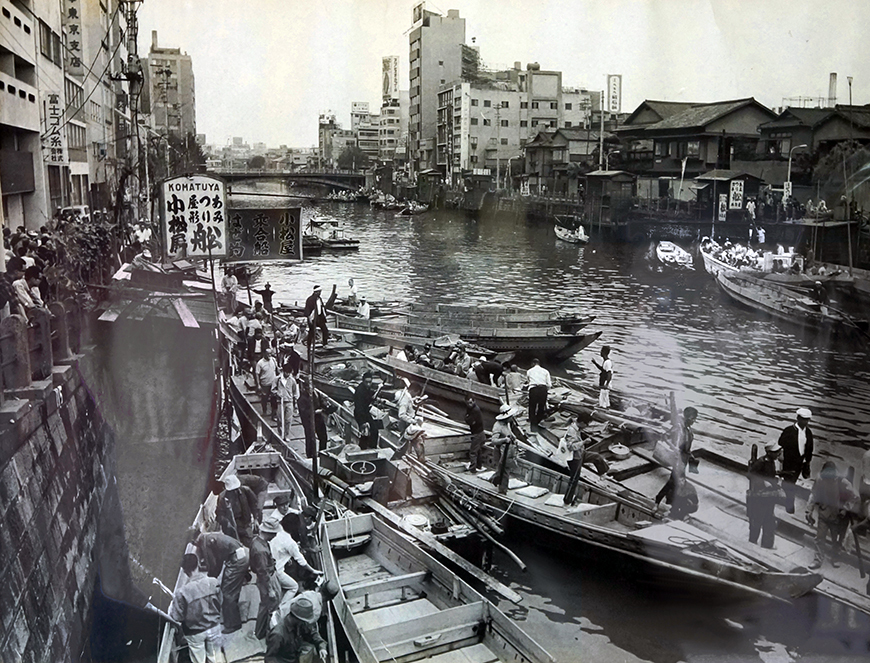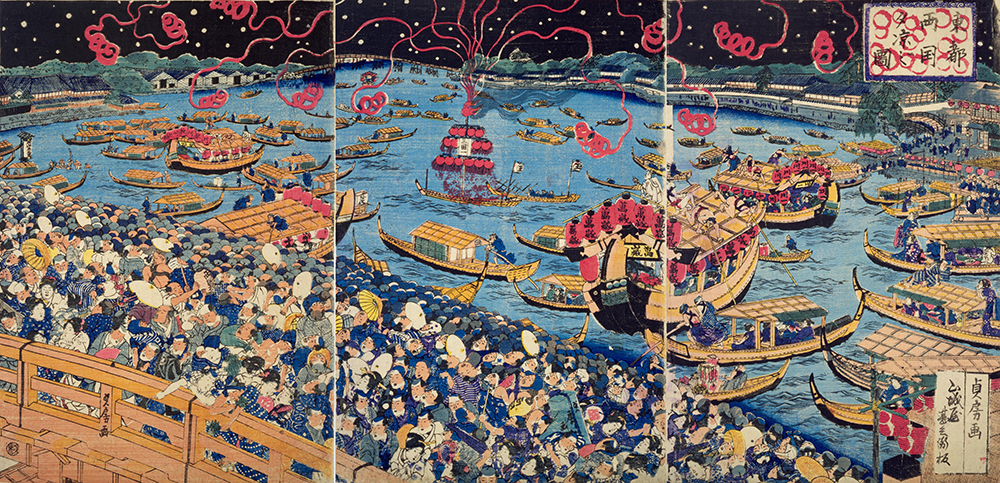
Q: Have you operated the pleasure-boat office since those days?
We moved from Komatsugawa to Yanagibashi in 1927, and provided customers boating entertainments, in which customers could enjoy casting net, fishing, evening cool, cherry blossom viewing, fireworks, excursion and houseboat. We went fishing when we could not do business during the war. As towns were revived after the war, people gathered along the Sumida River, and the fireworks event was also resumed. However, since the river was polluted and smelled during the period of high economic growth around 1968, we had to leave the river.
Later, in October 1976, a Japanese-style restaurant (Mr. Koyasu) informed us that fish broke the water near the Kiyosu Bridge across the Sumida River. When my father and mother went to see that, striped mullets leaped out of the water. About that time, there were no bubbles of methane and obnoxious smells, and the river began to be clean because wishes of many people deeply attached to the Sumida River were realized, their efforts bore fruit, and laws were improved. And, my parents and proprietresses of Japanese-style restaurants wanted to make houseboats go into service, so we, as Funayado Komatsuya, revived boathouses on June 17, 1977. Japanese-style restaurants and longtime customers were very delighted about it, and then, in an effort to revive cherry blossom viewing at the banks of the Sumida River, the Regatta Waseda vs Keio, and the fireworks event, people made approaches to concerned parties, leading to a revival of each event.
I think many people wanted the boathouses to be revived. The boathouses received media exposure, and were treated as if they were symbols of the clean river. Japanese-style restaurants also gradually flourished. I clearly remember that, when Funayado Komatsuya also revived cherry blossom viewing on boathouses running along the banks of the Sumida River, surprisingly many people boarded the boathouses. People began to pay attention to the Sumida River of which water quality was gradually improved, and we aimed to make the area along the river lively as it was before. (continued in the lower column)
Q: How did the present-day Sumida River Fireworks Festival begin?
"Ryogoku Kawabiraki Hanabi," or the fireworks event held on the day of a river festival of Ryogoku, was renamed "Sumida River Fireworks Festival" in 1978, and the fireworks event resumed. "Ryogoku Hanabi Kumiai," which had shot off fireworks for a long time, was dissolved, "Sumida River Fireworks Festival Executive Committee" came into being, and Taito and Sumida Cities started to shoot off fireworks in turn.
When the first plan was brought up, my father was asked about many things, including a date and time for shooting off fireworks, the number of barges, effects of the ebb and flow and the number of boats from which visitors see fireworks, and frequently visited the public offices. Since my father was in charge of boats for Ryogoku Kawabiraki Hanabi, and strongly wanted to revive the fireworks event, he was happy to take his part. I think both cities, police and fire stations, and related organizations faced tremendous difficulties in order to conduct the first event. Many people waited for the revival of the fireworks event. When the event was announced in newspapers and others, we received many inquiries and reservations for boats to see fireworks. (continued in the right column)
Funayado Komatsuya provided 70 boats for the first Sumida River Fireworks Festival, and visitors boarded the boats at our office, two sites along the Kanda River, and four piers on the Sumida River. At that time, we put up large lanterns of Komatsuya and wooden tags, on which visitors' names were written, on small wooden boats, and put them out to the river one after another. Since there were many boats, we put them out every 15 minutes from around 1 p.m. Since we could make use of the piers on the Sumida River for two years, we was in charge of helping customers of Japanese-style restaurants at Mukojima into boats at the piers. I remember that there were 15-16 boats in the first year, and 30-40 in the second year.
Fireworks were shot off from the opposite bank (the first venue) in front of the piers, and we could see all movements of fireworks experts, so we were totally fascinated with large fireworks that spread across the night sky. We could strongly feel a sense of anticipation from people before fireworks were shot off at the area around Mukojima. People shouted for joy when the first firework was shot off, held their breath as fireworks were set off one after another, and clapped their hands and cheered out loud when the last firework was displayed. We had a good time in which we could feel that people really waited for the event and enjoyed it from the bottom of their hearts. We were so happy to hear the roaring sounds of the fireworks and a stir in the audience. Even smoke of the fireworks, falling sparks and ash were pleasant for us. I was touched by the fireworks that I saw for the first time since seeing it when I was a child, and still remember it as if it was yesterday. (continued in the lower column)

Banks and platforms have been built along the Sumida River, and the view from a boat is fairly changed.
"Toto Ryogoku Yusuzumi no Zu" by Sadafusa Utagawa (Courtesy of the National Diet Library)

Q: Now Sumida River Fireworks Festival is the big event that signals summer in Tokyo, and covered live on TV. Where is it broadcast from?
TV Tokyo has exclusively broadcast the event live as a sponsor since the revival of it. Regarding points where the event is broadcast from, we were initially so busy putting boats out, and did not have time to watch TV, so I cannot certainly remember where it was broadcast from. When I see Ukiyo-e and colored woodblock prints of fireworks at Ryogoku, the Ryogoku Bridge is depicted, so it seems that the fireworks were shot off above the Ryogoku Bridge (a venue between the Ryogoku and Kuramae Bridges) and around Hamacho Gashi (near the Ryogoku and the present-day Shin-ohashi Bridges). In the Edo Period, restaurants located along Okawa set off fireworks in some events, so I think fireworks were shot off for those restaurants.

Mr. and Mrs. Sato, owners of Funayado Komatsuya










